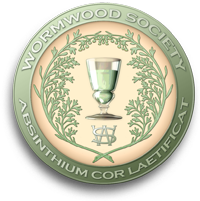Carafes Frappées: Iced Decanters
Here is an interesting collection of articles detailing the use—often depicted in absinthe advertising and art of the 1800s—of carafes containing large chunks of ice, frozen inside the carafe. Read about innovations in refrigeration and how these carafes were produced without breaking the glass.

Consumption of Ice in Paris
Journal of the Society of Arts, 1866, Volume 14, Page 335
“The use of ice is general in Paris during the summer months: it is supplied in almost every café and restaurant, and scarcely greengrocer or a milkshop in the better portions of town is without an ice-chest for the supply of its customers. The quantity consumed is said to amount to twelve or fifteen thousand tons a year.
Besides the sale of rough and pure ice there is a large trade done in are called carafes frappés, that is to say, water decanters or bottles, in which nearly the whole contents are frozen by rapid revolution in a freezing mixture. These carafes are supplied to the cafés and also to private families morning, and being constantly kept filled up with water serve throughout the whole day under ordinary temperatures. Another application of these carafes is to fill up with champagne or other wine, and thus to obtain cool and diluted drinks for evening parties in hot weather.”
Boston Journal of Chemistry, Vol. VI, No.1, page 1, 1871
“In the earlier forms of ice apparatus, the cold was produced by the evaporation of the water itself; the vapor being condensed by sulphuric acid, which has a strong affinity for aqueous vapor.
This method is still used in Paris in the production of carafes frappés or frozen decanters, which are frequently used at the restaurants. The apparatus used resembles a small steam-boiler; this is partially filled with concentrated sulphuric acid and then connected with an air-pump and with the flask to be frozen. The air-pump not only removes the air from the vessel, but connected with it is an agitator which serves to keep the acid continually stirred up, and thus prevents the formation of a layer of dilute acid on surface of the liquid in the vessel. If the vessel contains one hundred pounds of acid originally, it will serve to freeze about five hundred pounds of water.
The inventor, Mr. Edmond Carré, claims that this apparatus will furnish ice at a cost of about half a cent a pound, since the acid is as valuable for many purposes as it was being used. “

The Progress of Invention in the Nineteenth Century, 1900
By Edward Wright Byrn
“One of the earliest methods of producing ice in a limited quantity was by evaporating water by a reduction of pressure and causing the vapor to be absorbed by sulphuric acid, which has a great affinity for the water vapor.
Mr. Nairne, in 1777, was the first to discover the affinity that sulphuric acid had for water vapor, and in 1810 Leslie froze water by this means. In 1824 Vallance obtained British patents No. 4,884 and 5,001, operating on this principle, in which leaden balls were coated with sulphuric acid to increase the absorbing surfaces, and which apparatus was effective in freezing considerable quantities of ice.
The carafes frappées of the Parisian restaurant were decanters in which water was frozen by being immersed in tanks of sea water whose temperature was reduced below freezing by the vaporization of ether in a reservoir immersed in the sea water.
Edmond Carré’s method of preparing carafes frappées involved the use of the sulphuric acid principle of absorption, and to that end the aqueous vapor was directly exhausted from the decanter by a pump, and the said vapor was absorbed by a large volume of sulphuric acid so rapidly as to freeze the water remaining in the decanter.
